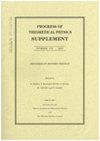Photoemission and the Electronic Structure of Transition Metal Compounds
引用次数: 3
Abstract
In this paper we study the valence electronic structure of 3d transition metal compounds in an Anderson impurity approximation. Using simplified models we arrive at a classification scheme (in terms of several parameters) for the nature of the band gaps in these materials. Mott-Hubbard insulators, in the simple sense, are special cases in this scheme. Another important class of insulators is characterized by light holes of ligand p character and heavy d-like electrons (charge-transfer semiconductors). Within the same theoretical basis we develop the theory describing the photoemission and inverse photoemission spectra from which one can obtain values for the parameters in the Anderson impurity Hamiltonian. Using an exact two particle Green's function formalism the photoemission of CuCl2 is studied and it is shown that this compound is a charge-transfer semi-conductor. For the more general case an approximate, easy to use method is developed and is applied to the (inverse) photoemission of NiO. It is shown that NiO can be characterized as being intermediate between the Mott-Hubbard and charge-transfer regimes.过渡金属化合物的光发射和电子结构
本文用安德森杂质近似法研究了三维过渡金属化合物的价电子结构。使用简化模型,我们得到了这些材料中带隙性质的分类方案(根据几个参数)。简单地说,莫特-哈伯德绝缘体是这个方案中的特殊情况。另一类重要的绝缘体具有配体p特征的轻空穴和重类d电子(电荷转移半导体)。在相同的理论基础上,我们发展了描述光发射和逆光发射光谱的理论,从中可以得到安德森杂质哈密顿量的参数值。利用精确的两粒子格林函数形式研究了CuCl2的光发射,证明了该化合物是一种电荷转移半导体。对于更一般的情况,提出了一种近似的、易于使用的方法,并将其应用于NiO的(逆)光电发射。结果表明,NiO可以被表征为介于Mott-Hubbard和电荷转移体系之间。
本文章由计算机程序翻译,如有差异,请以英文原文为准。
求助全文
约1分钟内获得全文
求助全文

 求助内容:
求助内容: 应助结果提醒方式:
应助结果提醒方式:


